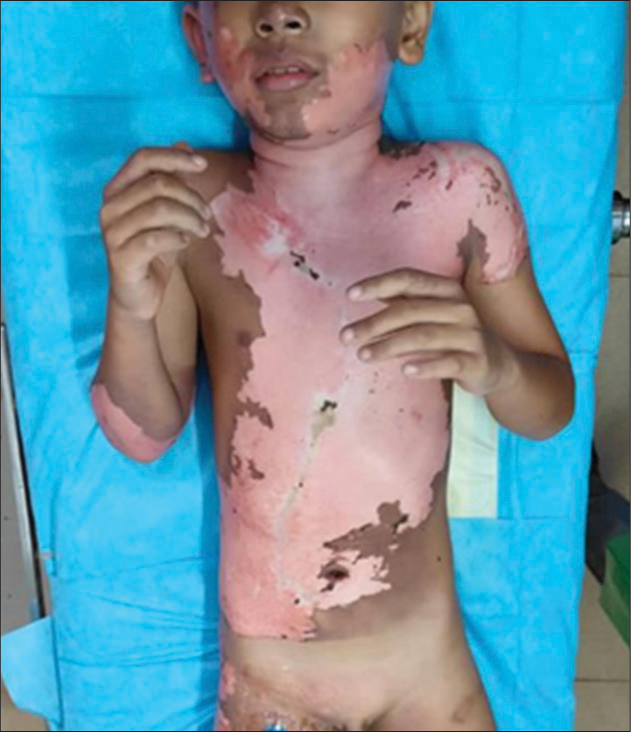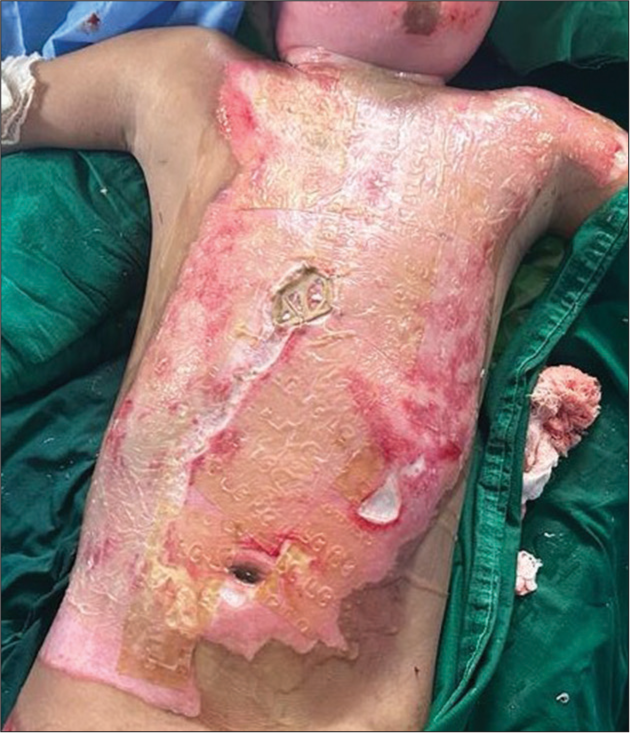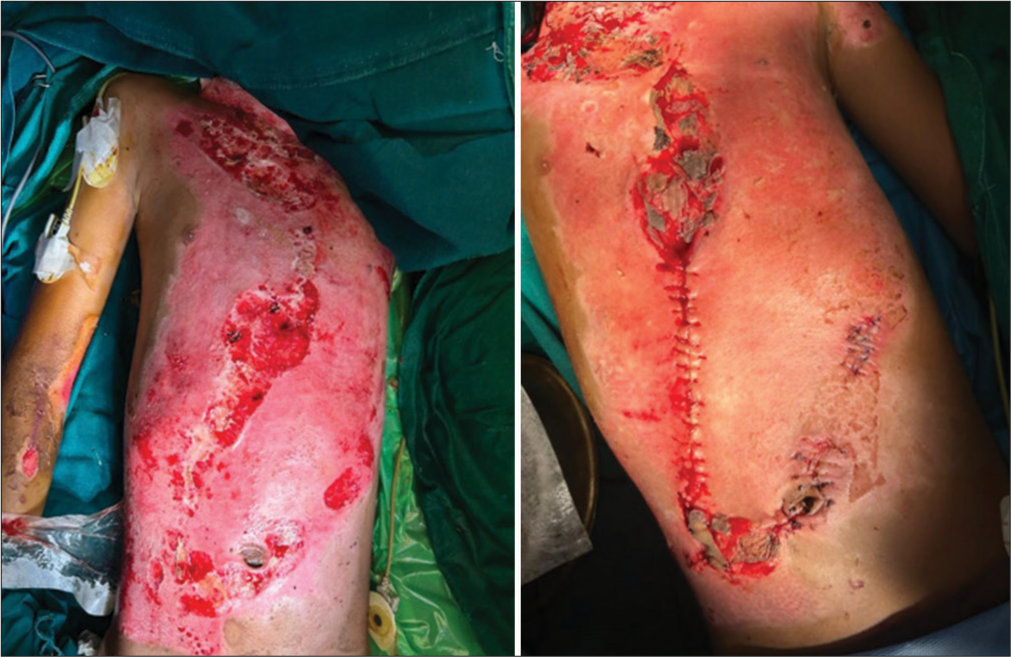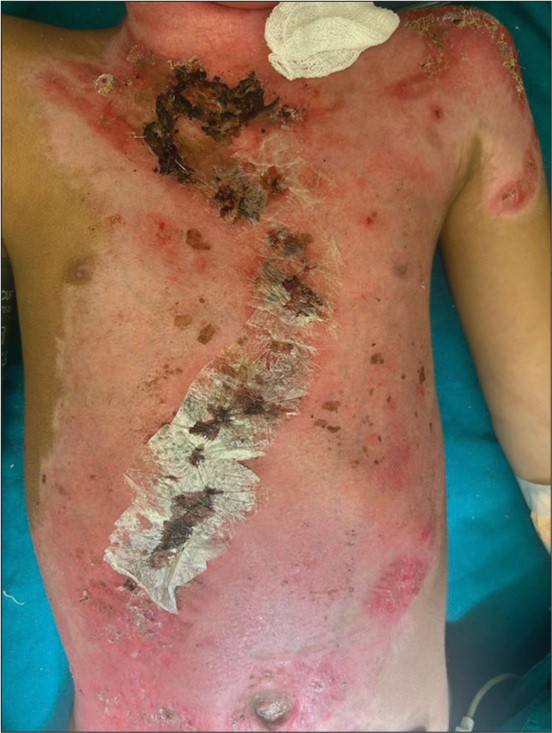Translate this page into:
Role of antimicrobial coated allogenic dried amniotic membrane in partial thickness burns

*Corresponding author: Ravi Kumar Chittoria, Department of Plastic Surgery, Jawaharlal Institute of Postgraduate Medical Education and Research, Puducherry, India. drchittoria@yahoo.com
-
Received: ,
Accepted: ,
How to cite this article: Chittoria RK, Barath Kumar Singh P, Pola V. Role of antimicrobial coated allogenic dried amniotic membrane in partial thickness burns. CosmoDerma 2023;3:174. doi: 10.25259/CSDM_223_2023
Abstract
Objectives:
Human amniotic membrane (HAM) is the biological scaffold for burn wound management. Allogenic HAM helps in promoting the healing of partial-thickness burn wounds. In this case study, we share our experience in using the antimicrobial-coated HAM.
Material and Methods:
The subject was an 8-year-old male child, who had accidental electrocution while playing near the electrical transformer and developed second-degree superficial and deep burns over the chest, abdomen, and bilateral lower limb. The child underwent tangential excision of the deep burns, and partial thickness burns are covered with dried allogenic HAM.
Results:
Intraoperative and postoperative periods were uneventful for the patient. The raw area took up the AM well, and burn wounds healed well in the second-degree superficial burns. A deep burns wound bed was prepared, and split skin grafting was done to the raw area. The wounds healed well after two weeks with minimal scarring. No complications or side effects were noted.
Conclusion:
Allogenic HAM plays a role in burn wound healing in burns. It helps in promoting the wound healing process.
Keywords
Antimicrobial
Amniotic membrane
Dried
Allogenic
Partial thickness burns
INTRODUCTION
Burn injuries in children remain a serious global epidemiologic concern. The youngsters under 16 account for over a quarter of all burn injuries. Most of the youngsters are under 5 years old.[1,2] The majority of thermal injuries in children under the age of five tend to be scalded injuries, making up over 65% of cases; on the other hand, fire injuries typically affect older children, making up over 56% of instances. Burn wound management is the focus once the child with burn injuries has had their critical care difficulties stabilized. The ultimate goals of burn restoration techniques are to conceal injuries, reestablish function, and maintain appearance. The three main surgical procedures for managing a wound are excision, grafting, and reconstruction.[3] Early excision and skin grafting minimize necrotic and diseased tissue while simultaneously enabling the first acute covering of burns. Regenerative treatments such as allogenic human amniotic membrane (HAM)[4] aid in the improvement of scar formation and the repair of second-degree superficial burns. In this instance, we assess the function of dried HAM covered with antimicrobial agents in managing a partial thickness burn wounds.
MATERIALS AND METHODS
This study was conducted in a tertiary care center in department of plastic surgery after getting the department’s ethical committee approval. Informed consent was obtained. The subject was an 8-year-old male child who had accidental electrocution while playing near the electrical transformer and developed second-degree superficial and deep burns over the chest, abdomen, and bilateral lower limb. On examination, he had second-degree burns over the chest, abdomen, and bilateral lower limb. There was a total of 40% surface area involvement [Figure 1]. The child underwent tangential excision of the deep burns and partial thickness burns are covered with dried allogenic HAM [Figures 2 and 3]. The commercial antimicrobial-coated dried allogenic HAM is available in various sizes in Indian market. The commercial preparation available in India is Amchoplast (life cell). The cost of the dried HAM of size 12 cm * 6 cm is 3500 Indian rupees. Poly-hexamethylene biguanide (PHMB) is a cationic polymer with antimicrobial and antiviral properties. It has been commonly accepted that the antimicrobial activity is due to the ability of PHMB to perforate the bacterial phospholipid membrane leading ultimately to its death. This chemical compound is coated on the dried amniotic membrane (AM) for antimicrobial activity. The dried AM is printed with alphabets LC on the outer side, which helps in placing the scaffold in the proper alignment. PHMB is best known for its broad-spectrum antimicrobial and antifungal activity.

- Burn wounds at presentation.

- Dermabrasion-assisted tangential excision.

- Application of antimicrobial coated allogenic human amniotic membrane.
RESULTS
Intraoperative and postoperative periods were uneventful for the patient. The raw area took up the AM well and burn wounds healed well in the second-degree superficial burns. A deep burns wound bed was prepared and split skin grafting was done to the raw area [Figure 4]. The wounds healed well after 2 weeks with minimal scarring [Figure 5]. No complications or side effects were noted.

- Healed second-degree superficial burn wound and skin grafting over deeper burns after 10 days.

- Healed burn wounds after 3 weeks.
DISCUSSION
The utilization of appropriate scaffold matrices is ultimately what drives skin tissue regeneration. Scaffolds can be porous, fibrous, microsphere-shaped, hydrogel-based, composite, or acellular. Ulcers that do not heal well, post-burn ulcers, and larger-area wounds that need to be covered require skin grafting or flap covering, depending on the situation. The greatest biological substance to cover a wound is skin. Certain situations prevent a patient from receiving skin grafting, such as major burns when additional skin is needed to cover a wound because sufficient skin is not present. We require biological material that is both efficient and economical to cover the wound and act as a barrier against wound infection. The AM of humans is thought to be a significant prospective source of scaffolding material for the creation of biological material with skin-like characteristics.[5,6] The single epithelial layer, the thick basement membrane, and the avascular stroma make up the HAM, which is the placenta’s deepest layer. The unique composition, biological durability, and convenient accessibility of the HAM render it a prime choice for the production of scaffolds utilized in tissue engineering.[7] The characteristics of the HAM can now be adjusted with the use of innovative preparation methods and composite scaffolding approaches. During tissue engineering, the AM is created to assist the host cells, encouraging their differentiation and proliferation as they build a new tissue. An essential first stage in the healing of wounds is the selection of the biomaterials to be employed as scaffolding.[7,8]
The inner, avascular layer of the fetal membrane’s three layers is called the AM. Davis successfully completed the first therapeutic skin transplant with AM in 1910. A crucial biological scaffold, the HAM is valued for its structure, biological characteristics, mechanical attributes, and low immunogenicity.[9] AM characteristics in humans are as follows:
A single layer of cuboidal or columnar epithelial cells;
A basal membrane that is ultrastructurally and morphologically similar to skin. Laminin and collagen types IV, VII, and XVII make up its composition. A dense layer without cells.
In terms of functionality, it is inexpensive, absorbs quickly, and clings to the wound bed somewhat loosely. Given that the majority of AMs are thrown away after childbirth, their availability is unlimited if appropriate preservation and storage measures are taken.
There are no nerves or blood vessels in the membrane.
Since it is generally acknowledged that AM serves as a substrate or scaffold for epithelial cell adhesion, migration, and development, the AM gets integrated into the host tissue. In essence, the AM acts as a biological bandage or coating to safeguard the healing surface underneath. Due to its low immunogenicity and lack of ability to generate unchecked growth, its application does not result in rejection.[10] Anti-inflammatory, anti-fibrotic, antibacterial, analgesic, and nontumorigenic activities are demonstrated by AM. The reason for the variety of its effects can be attributed to its ability to produce and release biologically active molecules, which include cytokines and signaling factors such as tumor necrosis factor-alpha, transforming growth factor-alpha, transforming growth factor-beta, basic fibroblast growth factor, epidermal growth factor (EGF), keratinocyte growth factor, hepatic growth factor, interleukin 4, interleukin-6, interleukin-8, natural inhibitors of metalloproteases, β-defensins, and prostaglandins. Although the physiological relevance of EGF binding to embryonic membranes is unknown, the significant amount of binding seen here indicates that these tissues are potential targets for EGF.[11] In tissue engineering projects, AM – which has a structure similar to that of a biological dermal stimulant – must be utilized as a scaffold for the development of epidermal stem cells. The decellularized HAM was then seeded with keratinocytes on the epithelial side and fibroblasts on the chorionic side to create a comparable skin structure. The HAM’s decellularization aids in the elimination of immunogenicity. Decellularization of the membrane is necessary to stop the spread of illness. There are methods available for denuding the HAM, including cryopreservation, ethylene diamine tetra acetic dispase II, trypsin, thermolysin, sodium hydroxide, sodium dodecyl sulfate, and urea.
The polymer polyhexanide (also known as PHMB) is used as an antiseptic and disinfectant. Under the brand names lavasept, serasept, prontosan, and omnicide, it is marketed for use in dermatology and is known as polyhexanide. PHMB is a cationic disinfectant that works by electrostatically attaching itself to negative spots on the lipopolysaccharide component of bacterial cell membranes, rendering it effective against both Gram-positive and Gram-negative bacteria. It has been demonstrated that PHMB works well against enterococci, Aspergillus brasiliensis, Candida albicans, Staphylococcus aureus, Escherichia coli, and Pseudomonas aeruginosa.[12]
Products containing PHMB are used for routine antisepsis during minor incisions, catheterization, first aid, surface disinfection, and linen disinfection; intraoperative irrigation; pre- and post-surgery skin and mucous membrane disinfection; postoperative dressings; surgical and non-surgical wound dressings; surgical bath/hydrotherapy; chronic wounds such as diabetic foot ulcers and burn wound management; and more. In addition, PHMB is a component of several cosmetics, deodorants, and cleaning solutions for contact lenses. It is also applied to garments to stop offensive scents from growing. Cell lysis is the outcome of this interaction, which causes the structure of the cell membrane to be disturbed and intracellular materials to flow out.[13] The side effects of this product were rare like allergic reactions were reported.
CONCLUSION
Allogenic HAM plays a role in burn wound healing in burns. It helps in promoting the wound healing process. It helps in better healing second-degree superficial burns and wound bed preparation for deep burn wounds for further intervention.
Declaration of patient consent
The authors certify that they have obtained all appropriate patient consent.
Conflicts of interest
There are no conflicts of interest.
Use of artificial intelligence (AI)-assisted technology for manuscript preparation
The authors confirm that there was no use of artificial intelligence (AI)-assisted technology for assisting in the writing or editing of the manuscript and no images were manipulated using AI.
Financial support and sponsorship
Nil.
References
- Burn wound: How it differs from other wounds? Indian J Plast Surg. 2012;45:364-73.
- [CrossRef] [PubMed] [Google Scholar]
- Burn wound healing: Clinical complications, medical care, treatment, and dressing types: The current state of knowledge for clinical practice. Int J Environ Res Public Health. 2022;19:1338.
- [CrossRef] [PubMed] [Google Scholar]
- The microscopic anatomy of the human amnion and chorion. Am J Obstet Gynecol. 1960;79:1070-3.
- [CrossRef] [PubMed] [Google Scholar]
- The microscopic anatomy of the fetal membranes with particular reference to the detailed structure of the amnion. Am J Obstet Gynecol. 1958;75:536-50.
- [CrossRef] [PubMed] [Google Scholar]
- Amniotic membrane: From structure and functions to clinical applications. Cell Tissue Res. 2012;349:447-58.
- [CrossRef] [PubMed] [Google Scholar]
- A skin substitute based on human amniotic membrane. Cell Tissue Bank. 2014;15:257-65.
- [CrossRef] [PubMed] [Google Scholar]
- The effect of long-term storage on the biological and histological properties of cryopreserved amniotic membrane. Curr Eye Res. 2011;36:247-55.
- [CrossRef] [PubMed] [Google Scholar]
- Understanding the impact of preservation methods on the integrity and functionality of placental allografts. Ann Plast Surg. 2017;79:203-13.
- [CrossRef] [Google Scholar]
- Efficacy of human amniotic membrane and collagen in maxillofacial soft tissue defects-a comparative clinical study. J Oral Maxillofac Surg Med Pathol. 2015;27:786-90.
- [CrossRef] [Google Scholar]
- Soluble factors released by endogenous viable cells enhance the antioxidant and chemoattractive activities of cryopreserved amniotic membrane. Adv Wound Care (New Rochelle). 2015;4:329-38.
- [CrossRef] [PubMed] [Google Scholar]
- Inhibition of the anti-staphylococcal activity of the antiseptic polihexanide by mucin. Arzneimittelforschung. 2003;53:368-71.
- [CrossRef] [PubMed] [Google Scholar]
- Insights into the polyhexamethylene biguanide (PHMB) mechanism of action on bacterial membrane and DNA: A molecular dynamics study. J Phys Chem B. 2020;124:4487-97.
- [CrossRef] [PubMed] [Google Scholar]






